BOOKS
2025
NANAK ET SA PHILOSOPHI
Prof Devinder Singh Chahal, PhD
Traducteur: Dr. David Breme,
chargé de cours, Université Laval, Québec,
Québec, Canada
Informations pour acquérir ce livre:
Veuillez contacter David Brême au courriel: [email protected] en laissant vos coordonnées postales.
ISBN: 978-2-89775-981-0
Book Information:
Informations pour acquérir ce livre
Veuillez contacter David Brême au courriel: [email protected] en laissant vos coordonnées postales.
ਸਚ1 ਕੀ ਬਾਣੀ2 ਨਾਨਕੁ ਆਖੈ3 ਸਚੁ4 ਸੁਣਾਇਸੀ5 ਸਚ6 ਕੀ ਬੇਲਾ7 ॥੨॥੩॥੫॥
Sacẖ kī baṇī Nānak ākẖai sacẖ suṇāisī sacẖ kī belā. ||2||3||5||
AGGS, M 1, p 723
Quand j’observe de manière approfondie le sikhisme, comme il est prêché, je vois qu’il est promu comme une religion mystique, ésotérique, énigmatique et ritualistique. De plus, tout le monde, spécialement tous les sikhs, croient que Nanak (1469-1539) est le fondateur du sikhisme. Le fait est que Nanak a fondé la ‘Sikhi’ (philosophie éveillante) et que le ‘sikhisme’ (religion) a été développé par les disciples de Gourou Nanak comme expliqué au chapitre 12 s’intitulant ‘Sikh, Sikhi et sikhisme’. Récemment, plusieurs érudits et écrivains sikhs ont utilisé le terme de Sikhi au lieu de sikhisme, sans comprendre que la Sikhi est la philosophie éveillante fondée par Gourou Nanak. Le livre Nanak et sa philosophie, logiquement et scientifiquement révisé et ayant mis à jour l’édition du précédent livre, Nanakian Philosophy: Basics for Humanity, 2008, auquel de nouveaux articles ont été ajoutés. Comme enseigné par Gourou Nanak, j’ai essayé d’écrire la vérité là où elle devrait être dans ce nouveau livre. Ce livre traite seulement de Nanak et de sa philosophie, et n’a pas pour propos de parler du sikhisme. Néanmoins, le sikhisme est critiqué par des Occidentaux et des universitaires des études sikhes. C’est la raison pour laquelle j’ai analysé de façon critique leurs critiques et à quel point ils ont raison ou tort selon la Sikhi et la philosophie nanakienne.
Le livre Nanak et sa philosophie discute au fil de ses chapitres de « Qui est Nanak? », « Nanak le Gourou » et « Nanak, le philosophe naturel ». Ensuite est défini la méthodologie nanakienne et la philosophie nanakienne. Il est souvent dit et considéré que Dieu a révélé la bani à Gourou Nanak et aux autres Gourous, aux bhagats (saints poètes dévotionnels) et aux bhatts (troubadours). Cependant, Gourou Nanak n’a mentionné nulle part que Dieu lui a révélé la bani (chapitre 8). Gourou Nanak conceptualise l’Entité Éternelle (communément nommée Dieu) par un logo, , communément prononcé Ek Oankar. Toutefois, Oankar, représente le OM associé à Brahma, Vishnou et Shiva, ce qui conduit la Sikhi et le sikhisme dans le concept de Sanata Dharma. Dans ces circonstances et sous aucune circonstance, ne peut se justifier comme Ek Oankar, car il se compose comme suit:
ੴ = ੧ + ਓ +  .
.
ੴ et ses attributs ont été discutés en détail aux chapitres 8 et 9. Après, Hukm (lois de la Nature et de l’Univers) et la cosmologie sont discutées aux chapitres 10 et 11. Il a été noté que les Gourous sikhs ont utilisé la philosophie nanakienne dans certaines phrases mot à mot ou dans des mots légèrement différents, comme mentionné au chapitre 13. Des universitaires des études sikhes pensent que la bani de Bhagat Kabir est comme celle de Gourou Nanak, ce que j’ai contesté au chapitre 14. Naam et Naam Japna sont abordés au chapitre 15. La relation entre les Yugas (ère cosmique), les Védas et la bani de Gourou Nanak est expliquée au chapitre 16. Le système des mantras est abordé au chapitre 17 et le rôle des Ardas (prières) est discuté au chapitre 18. Les régimes alimentaires, spécialement regardant le régime carné, sont discutés au chapitre 19. Finalement, ce qui arrive après la mort est abordé au chapitre 20. De plus, quelques principes de base de la Sikhi de Nanak, la philosophie éveillante, ont été expliqués logiquement et scientifiquement comme référentiels utilisables pour la recherche académique dans le dernier chapitre.
Le livre est disponible aux éditions de l’Apothéose
www.leseditionsdelapotheose.com
Lanoraie, J0K 1E0, Québec
[email protected]
et auprès du Dr. David Brême
[email protected]
CAN 35$, US 30$, Euros 25€

2023
Nanak and his Philosophy
Prof Devinder Singh Chahal, PhD
ISBN: 978-0-9734291-7-6
Book Information:
Please E-mail Singh Brothers, Amritsar to get a copy of this bookComplete address is at the bottom.
ਸਚ1 ਕੀ ਬਾਣੀ2 ਨਾਨਕੁ ਆਖੈ3 ਸਚੁ4 ਸੁਣਾਇਸੀ5 ਸਚ6 ਕੀ ਬੇਲਾ7 ॥੨॥੩॥੫॥
Sacẖ kī baṇī Nānak ākẖai sacẖ suṇāisī sacẖ kī belā. ||2||3||5||
Nanak says3 the Bani (words)2 of truth2 and speaks5 the truth4 at the right time7 when the truth6 is to be spoken.
AGGS, M 1, p 723
When I look deeply into Sikhism, as it is being preached, I find it is promoted as a mystical, esoteric, enigmatic, and ritualistic religion. Besides, everybody, especially all the Sikhs, believes Nanak (1469-1539) is the founder of Sikhism. The fact is that Nanak founded ‘Sikhi’ (Enlightening Philosophy), and ‘Sikhism’ (Religion) was developed by the followers of Guru Nanak, as explained in Chapter 12 Sikh, Sikhi, and Sikhism. Recently, many Sikh scholars and writers have been using ‘Sikhi’ instead of ’Sikhism’ without understanding that ‘Sikhi’ is an enlightening philosophy founded by Guru Nanak. The book Nanak and His Philosophy is a logically and scientifically revised and updated edition of the previous book, Nanakian Philosophy: Basics for Humanity, 2008, in which some new articles have been added. As taught by Nanak, I have tried to write the truth at the right place in this new book. This book covers Nanak and his philosophy only but nothing about Sikhism. Nevertheless, Sikhism is criticized by Western and Sikh scholars. Therefore, I have critically analyzed their criticism and how far they are right or wrong according to Sikhi and Nanakian Philosophy.
The book Nanak and His Philosophy discusses Who is Nanak? Nanak - The Guru, and Nanak -The Natural Philosopher. Thereafter, it defines Nanakian Methodology and Nanakian Philosophy. It is generally accepted that God revealed bani to Guru Nanak and other Gurus, Bhagats, and Bhatts. However, Guru Nanak has not mentioned anywhere that God revealed bani to him (Chapter 8). Guru Nanak conceptualized the Eternal Entity (commonly called God) as a logo, ੴ, commonly pronounced as Ek Oankar. However, Oankar – represents OM – Brahma, Vishnu, and Shiva, which leads Sikhi and Sikhism into Sanatana Dharma. ੴ cannot be justified as Ek Onakar under any circumstances because it is composed as follows:
ੴ = ੧ + ਓ +  .
.
ੴ and its attributes have been discussed in detail in Chapters 8 and 9. Thereafter, Hukm (Laws of Nature/Universe) and Cosmology are discussed in Chapters 10 and 11. It has been observed that the Sikh Gurus have used Nanakian Philosophy in some phrases word by word or in slightly different words, as reported in Chapter 13. Some Sikh scholars think that the bani of Bhagat Kabir is like that of Guru Nanak (Chapter 14). Naam and Naam Japna are discussed in Chapter 15. The relationship between the Yuga, Vedas, and Bani of Guru Nanak is explained in Chapter 16. The Matra System is discussed in Chapter 17, and Ardas is discussed in Chapter 18. Food Fads, especially with reference to eating meat, are discussed in Chapter 19. Finally, what happens after death is discussed in Chapter 20. Besides, some basic principles of Nanak's Sikhi (Enlightening Philosophy) have been explained logically and scientifically as a ready reference to the research scholars.
The book is available from:
Singh Brothers, Amritsar
SCO 223-224 City Center,
Near Guru Nanak Bhawan,
Amritsar-143001, Punjab
Indian Rs 795.00; CAN$ 25.00: US$ 20.00: UK£ 15.00
[email protected]
Phone numbers: 0183-254-3965; 255-0739; 254-5787; or +91-99150 48005.
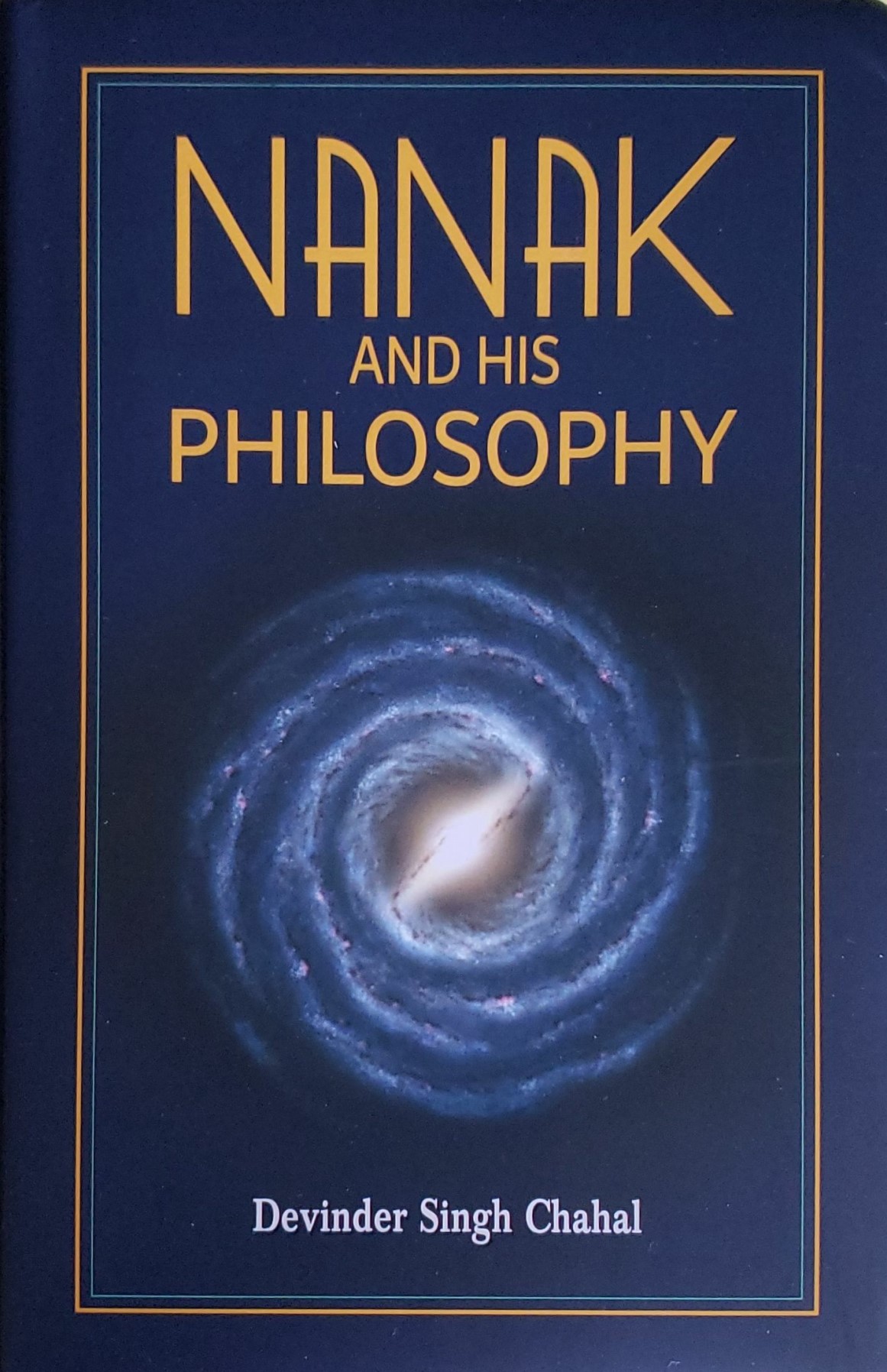
2018
JAP: The Essence of Nanakian Philosophy
(a scientific and logical interpretation)
REVISED VERSION
Prof Devinder Singh Chahal, PhD
ISBN: 978-8-1701049-7-1
Book Information:
Guru Nanak (1469-1539) laid the foundation of a universally acceptable philosophy for humanity. Today, Sikhism is considered the fifth largest faith in the world, but it is continuously being misrepresented under the influence of Vedanta and ancient philosophy. Therefore, many Sikhs do not understand the philosophy of Guru Nanak in its real perspective. The JAP Bani of Guru Nanak is recited in the morning by most of the Sikhs without understanding its philosophy. Guru Nanak has summarized his philosophy in JAP bani. Guru Arjun placed JAP bani at the beginning of the Aad Guru Granth Sahib. We interpreted JAP: The Essence of Nanakian Philosophy in 2003, scientifically and logically, so that the readers can understand the philosophy of Guru Nanak from its real perspective. The current book, JAP: The Essence of Nanakian Philosophy (a scientific and logical interpretation), is a revised and updated version of its First Edition 2003.
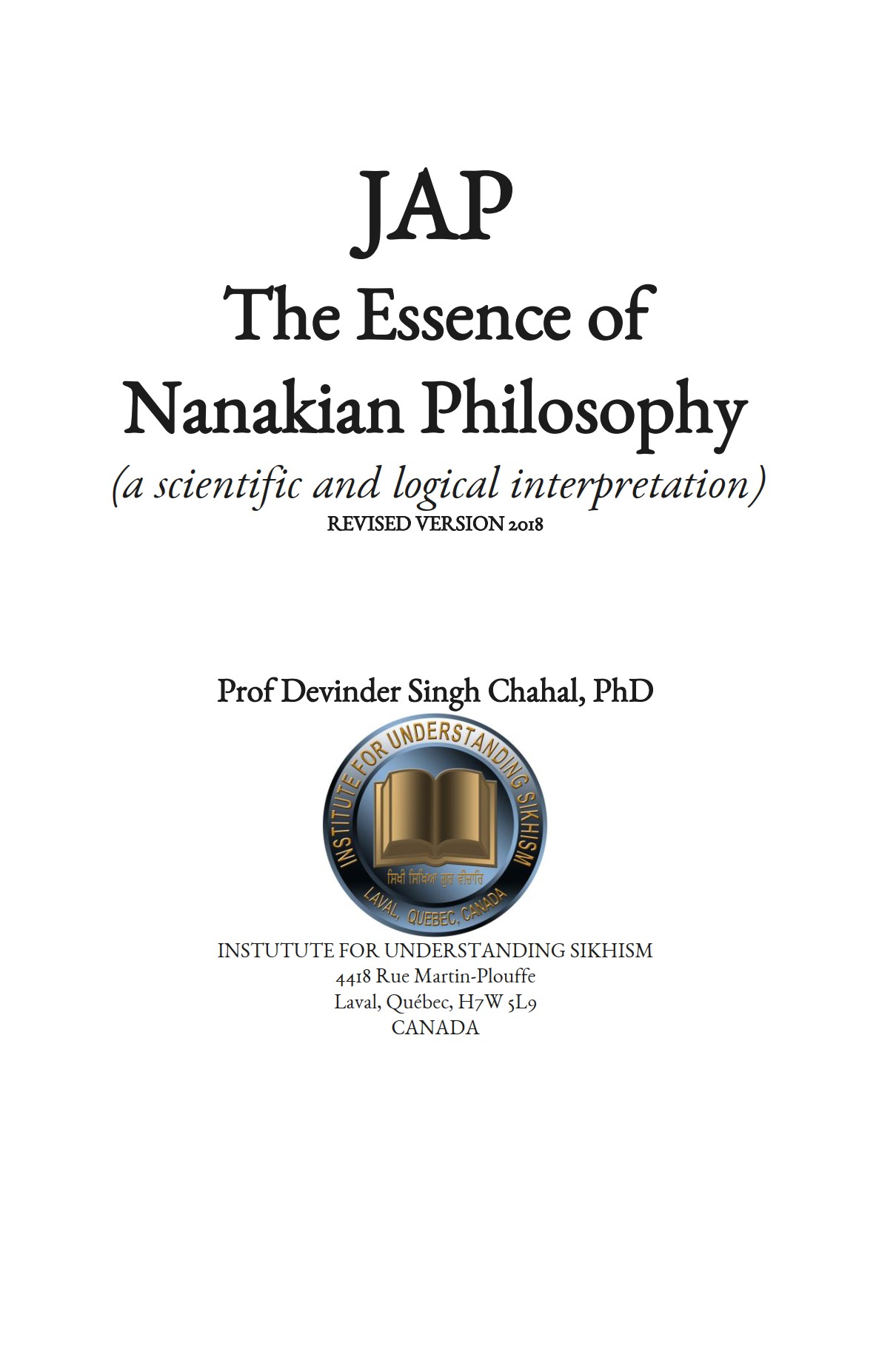
2016
JAP The Verses of Guru Nanak
Prof Devinder Singh Chahal, PhD;
Dr Kulbir Singh Thind, MD
ISBN: 978-0-9734291-5-2
Book Information:
The IUS Research Monograph #6
This book is available on-line to download.

2015
NANAK: The Guru, The Founder of Sikhism
Prof Devinder Singh Chahal, PhD;
Dr Kulbir Singh Thind, MD;
Dr Avtar Singh Dhaliwal, MD
ISBN: 978-0-9734291-4-5
Book Information:
The IUS Research Monograph #5
PREFACE
Many books and articles have already been written about Guru Nanak's life and his contributions. Some present him as a mystic man and a prophet sent by God for the welfare of humanity; others write that he was a reformer and follower of the Bhagati Movement so much so that some say that he was a follower of Bhagat Kabir. Still others are of the view that he was creating a bridge between Hinduism and Islam. Currently the general trend is to represent him as a preacher of Vedantic philosophy, although even those who present him in this way admit that on certain points he differed from Hinduism.
A critical analysis of the literature indicates that there is a great need to represent him based upon his philosophy as embodied in his bani. However, the various interpretations of his bani currently available have been done under the shadow of Vedanta. We, however, have interpreted his bani by using the application of science and logic to represent the real theme / philosophy in it. Now the question is:Who is Nanak? In this book it has been tried to represent Nanak as the Guru based on the Gurbani incorporated in the Aad Guru Granth Sahib. In our subsequent books his bani will be interpreted by using the application of science and logic. Some of the basic principles of his philosophy are presented in this book. To comprehend the truth in the bani as written and promulgated by Guru Nanak, one must compare the results of preconceived opinions of the 'Unknown' by historical interpreters which are based on theology against the scientific approach appreciated and adapted by Guru Nanak himself. He applied all the evidence including historical; and religious literature and religious praxis in search of the truth. He came to the realization that the ultimate explanation of reality lies in accepting the freedom of natural phenomena (Hukm - ਹੁਕਮੁ) and living by (ਮੰਨੈ) it. This book is only an introduction to the founder of Sikhi(sm) and its basic principles. Guru Nanak, the founder of Sikhi(sm) (1469-1539 CE), was a divinely inspired, well- educated by the mentors of Islam and Hinduism, and extensively travelled person who, at very young age, had realized the 'Truth' about the Reality - God and natural phenomena. From his writings incorporated in the Aad Guru Granth Sahib, the Holy Scripture, it becomes obvious that through discourses, discussions and observation of the praxis in various religions, he discovered religious mentors deluged with ego (haumae haUmY ), promulgating nothing more than chaos by indulging in self- serving gains. Knowing that humanity in general has the capacity to be deceived or deceives itself by believing in anything but the truth; most religious authorities with their clever, but often abstruse meanings have shielded the ancient interpretations of the Reality from humanity. They have promulgated the presence of a fearful and judgmental God in the very midst of human ignorance, doubts, fears, and sinfulness. It was these superfluous and superstitious beliefs of which Guru Nanak and the succeeding Sikh Gurus did not approve. For these reasons this booklet has been written and published using critical analysis (Bibek Budhi) to evaluate "historical theology" and the false promulgation of religious ethos. This booklet reflects the brief life history of Guru Nanak, the political and religious chaos in India during early 15th and 16th century, the travels of Guru Nanak, and the declaration and honoring of Nanak as the Guru. It also discusses the story of the revelation to Guru Nanak when he emerged out of Vein rivulet after three days and the story about the succession of Bhai Lehna to the 'House of Nanak'. All other fictitious stories about his life, found in various Janam Sakhis (biographies), have been avoided. The question of whether the philosophy of Guru Nanak is original and unique has also been explained in brief. The Gurbani phrases or Sabds and their transliterations have been copied with permission from www.srigranth.org, maintained by Dr Kulbir Singh's son, Jasjeet Singh Thind. The interpretations of these phrases and Sabd are either by the authors or by some other authors and in that case their names are mentioned at appropriate places. The manuscript has been critically edited by Mr Jesse Schell from New Zealand to make it understandable by native English speakers in Western countries.

2008
NANAKIAN PHILOSOPHY- Basics for Humanity
Prof Devinder Singh Chahal, PhD
ISBN: 978-0-9734291-3-8
Book Information:
Whenever I read interpretations of Gurbani by various Sikh and non-Sikh theologians, writers, and researchers, it reminds me of the following observations of Professor Puran Singh’s study of the 1920s:
“It is to be regretted that Sikh and Hindu scholars are interpreting Guru Nanak in the futile terms of the colour he used, the brush he took; are analyzing the skin and flesh of his words and dissecting texts to find the Guru’s meaning to be the same as of the Vedas and Upanishad. This indicates enslavement to the power of Brahmanical tradition. Dead words are used to interpret the fire of the Master’s soul! The results are always grotesque and clumsy translations which have no meaning at all.”
The irony is that it is still going on as recorded by Taran Singh, the then Head, Department of Sri Guru Granth Sahib Studies, Punjabi University, Patiala. He made it clear that Gurus’ philosophy was not only accepted as Vedantic philosophy by the early Sikh scholars of the 17th to 19th century, but contemporary university scholars also confirmed it as such. This type of work done by university scholars and other writers has encouraged some scholars to declare clearly and loudly that there is nothing new in the philosophy of Guru Nanak since it is based on the Vedas and Upanishads.
Now the question before us is:
Is the philosophy of Guru Nanak Original and Unique?
To answer the above question, the following remarks of Arnold Toynbee, the world-renowned historian, have touched my heart considering it seriously:
“Mankind’s religious future may be obscure, yet one thing can be foreseen: the living higher religions are going to influence each other more than ever before in these days of increasing communication between all parts of the world and all branches of the human race in this coming religious debate, the Sikh religion, and its scriptures the Adi Granth, will have something of special value to say to the rest of the world.”
Toynbee’s above remarks inspired me to conduct research to explore if there is any originality and uniqueness in the philosophy of Guru Nanak embodied in his Bani, which could have special value to the rest of the world. In this respect, the Institute for Understanding Sikhism, Laval, Québec, Canada, has already published two research monographs, ‘JAP: The Essence of Nanakian Philosophy’ and ‘Sabd Guru to Granth Guru’, to meet the above challenge. The current research monograph, ‘NANAKIAN PHILOSOPHY’, has been written especially for the humanity of the Science Age to portray its originality and uniqueness and its universal acceptability and applicability during the 21st century.
Since the book is entitled ‘NANAKIAN PHILOSOPHY’, the term, which is not familiar to many Sikh theologians, scholars, and researchers of Gurbani, was defined. Since there was no standardized system of referencing the Bani from the AGGS and every writer has been using his/her own system, therefore, a chapter on the system of referencing the Bani from the Holy Granth of the Sikhs has been added to this book as a guidance for the researchers of Gurbani to bring uniformity in referencing the Bani in Sikh literature. A chapter, ‘Misinterpretation of Gurbani,’ has been written to convince the readers that the application of scientific information and logical interpretation can reveal the real theme of the Bani. I do not claim that my interpretation is the final truth; however, I can vouch that it is as close to the real perspective as possible, subject to further improvement.
It was noticed that even the very ‘Commencing Verse’ of the AGGS, erroneously called Mool Mantra, is not well understood by many theologians and researchers. So I have discussed the ‘Commencing Verse’ in three chapters. Then ‘Concept of God’ and ‘God vs. Science’ have been discussed in two chapters.
After portraying the major principles of Nanakian Philosophy I turned to discuss Cosmology as understood by Guru Nanak, which is almost comparable to what is being theorized by the Astronomers and Physicists in these days. Thus, I have discussed ‘Origin of the Universe,’ Hukm – The Laws of Nature,’ ‘Astrology,’ and ‘Vedas and Yuga.’ Thereafter, I turned towards religiosity. On this issue, I have discussed ‘Mantra System,’ Naam Japna and Naam Simarna,’ Ardaas,’ ‘Life, Death’ and Soul,’ ‘After Death – Heaven and Hell,’ and ‘Food Fads.’
Finally, I discussed ‘Nanakian Philosophy and Science and ‘Nanakian Philosophy for World Peace.’
I have tried to portray the philosophy of Guru Nanak scientifically and logically in its real perspective. Now it is up to the erudite researchers, theologians, and critics with Babaek Budhi (discriminating intellect) to find out if this study represents the originality and uniqueness of ‘Nanakian Philosophy’, which also portrays its universal acceptability and applicability by the humanity of Current Science Age, or it is syncretism or it is based on Vedantic philosophy as has been said in the past and still is being preached so.
In spite of my above statement I sincerely hope that this study could also be a steppingstone or foundation for interpretation of the Aad Guru Granth Sahib (AGGS) into a Standardized English Translation. The resulting Standardized English Translation could serve as a role model for further translations of the AGGS into the world languages to disseminate Nanakian Philosophy in the world.
Chapter 1 of this book can be read by the link on the left side.
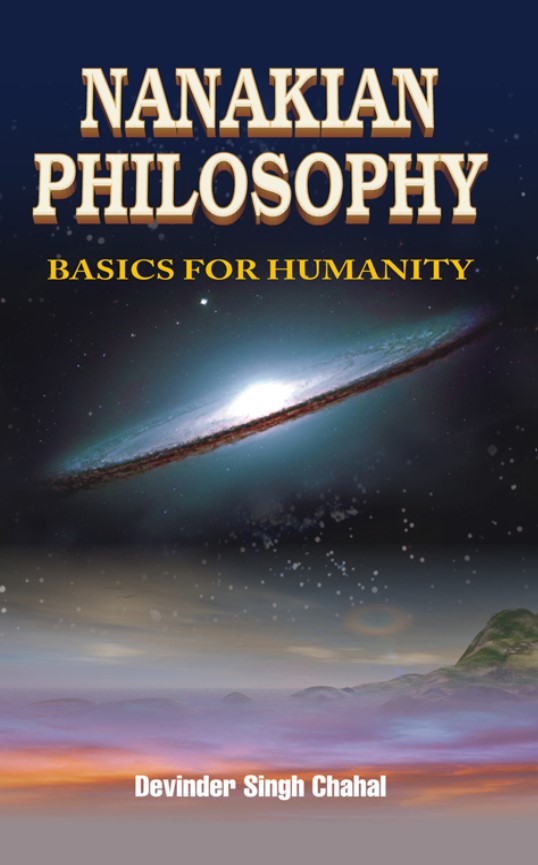
2006
SOME SALIENT PRINCIPLES OF SIKHISM
Prof Devinder Singh Chahal, PhD
ISBN: 978-0-9734291-2-7
Book Information:
In this booklet, the author has tried to explain some of the salient principles of Sikhism based on the philosophy of Guru Nanak embodied in his Bani (word). Guru Arjun authenticated that bani and incorporated it in the Aad Guru Granth Sahib in 1604. Besides, it has also been explained that Nanak has been accepted as their “Guru” by Guru Angad, Guru Amar Das, Guru Ram Das, and Guru Arjun. These salient principles of Sikhism are a ready reference for a common Sikh to talk about Sikhism.
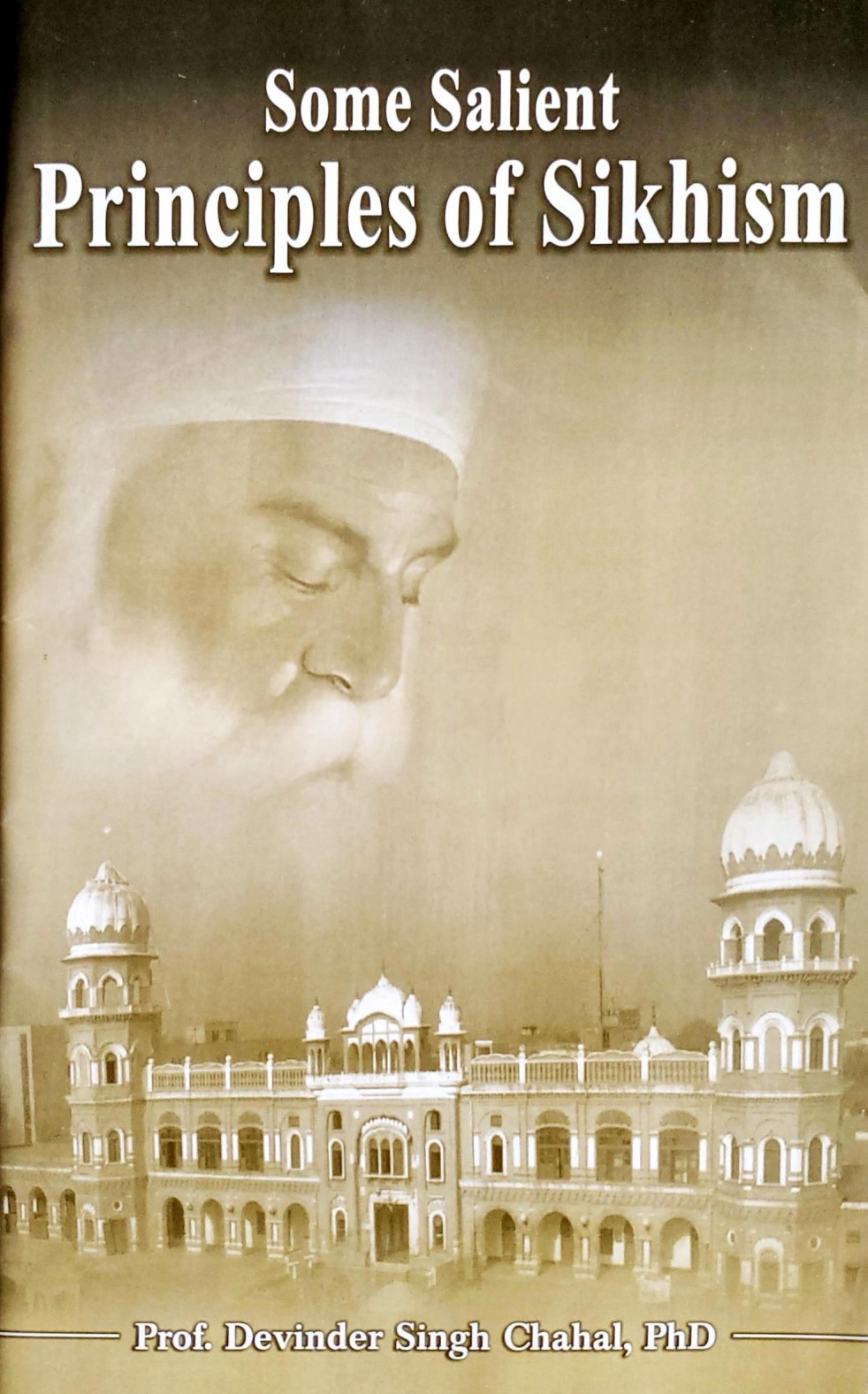
2004
SABD GURU TO GRANTH GURU:
AN IN-DEPTH STUDY
First Edition
Prof Devinder Singh Chahal, PhD
ISBN: 978-0-9734291-1-4
Book Information:
The author has noticed that there is confusion about the use of Sabd, Guru, Sabd Guru, and Granth Guru in Sikh literature. Since the Sikhs are celebrating the 400th Anniversary of the Compilation and Installation (Parkash Divas) of the Aad Guru Granth Sahib in 2004 throughout the world, therefore, it necessitated writing a book on this occasion to give an in-depth understanding of these terms according to Nanakian Philosophy. In this book, Sabd Guru To Granth Guru: An In-depth Study, it has attempted to explain the intrinsic values of Sabd, Guru, and Sabd Guru, and finally, to understand the status of the Granth Guru.
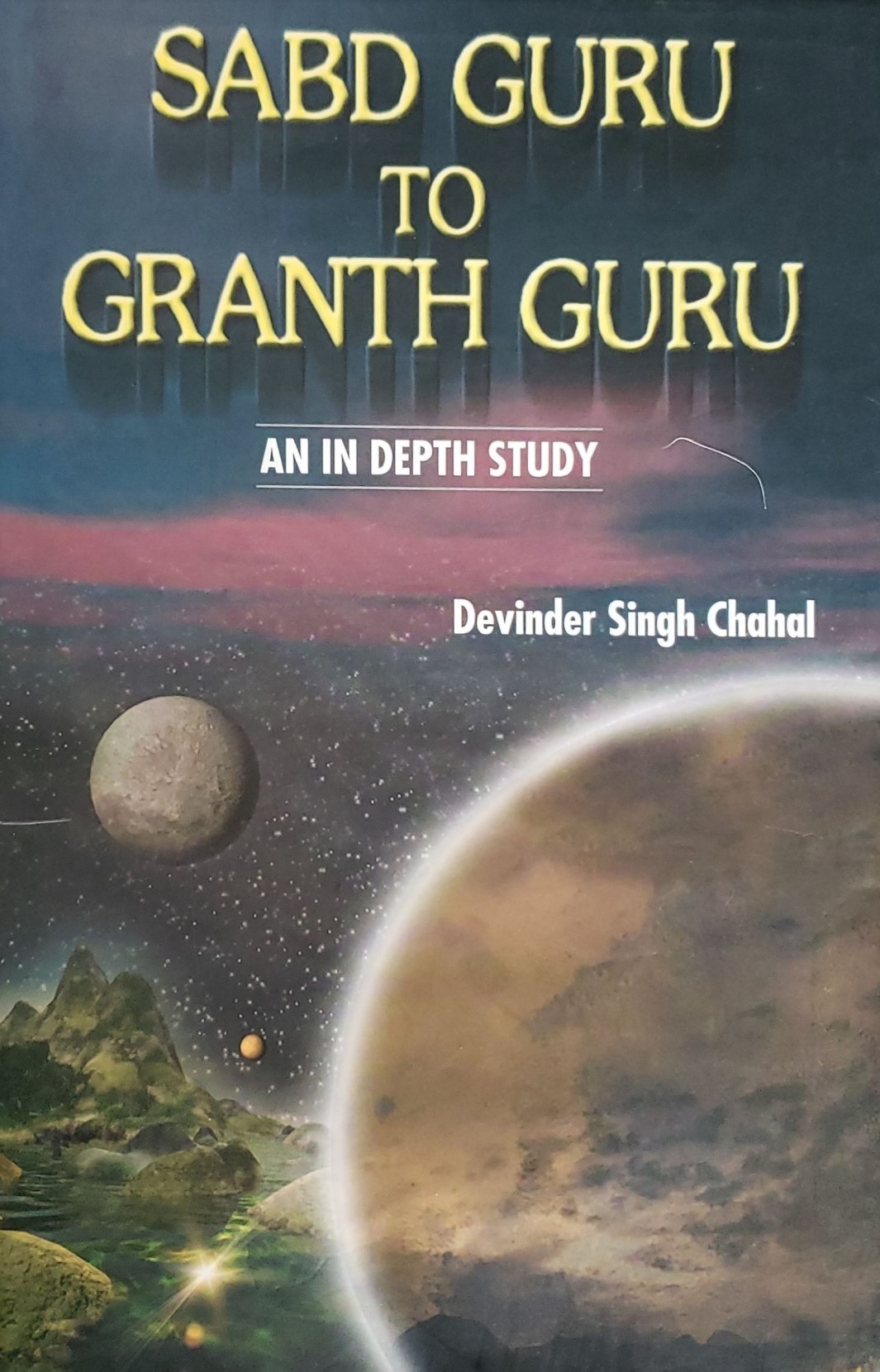
2003
JAP: The Essence of Nanakian Philosophy
A Scientific and Logical Interpretation
First Edition
Prof Devinder Singh Chahal, PhD
ISBN: not available
Book Information:
JAP is such an important part of Gurbani that it has been incorporated at the beginning of the Aad Guru Granth Sahib (AGGS). Due to its importance in the lives of the Sikhs JAP has been interpreted and translated into many languages of the world by many scholars of various faiths. It is estimated that there are hundreds of such interpretations since its realization by Guru Nanak sometime during the 15th or 16th century. It has been noticed that Jap Bani has been interpreted under the influence of Hindu philosophy. Therefore, the Sikhs are not getting t
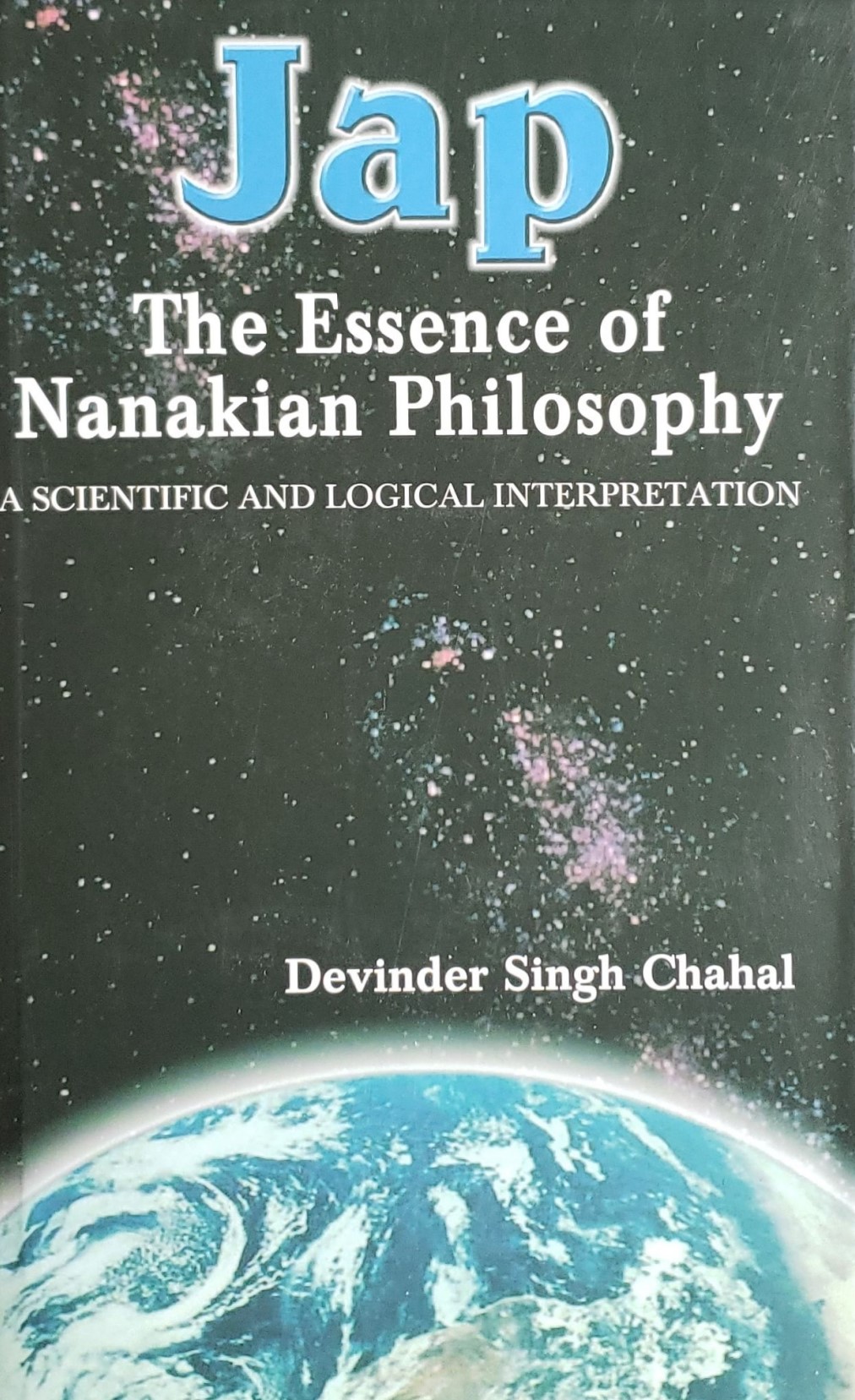
 View PDF
View PDF